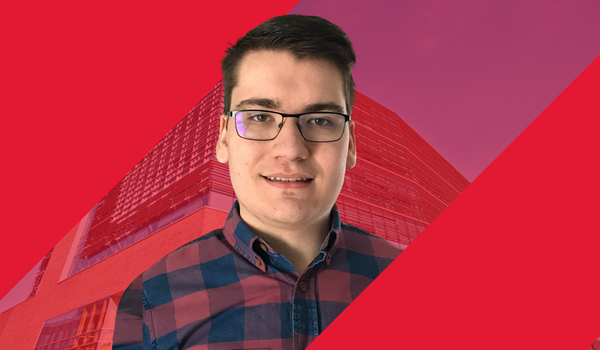Ryan Trask has always been interested in logical problem-solving. This interest of his lends itself to hobbies like chess, puzzles, and video games such as StarCraft. Trask appreciates these hobbies due to their respective learning curves. This logical problem-solving interest of his has driven his determination to someday fulfill his dream of working in biotech.
Trask chose to study biocomputational engineering (BCE) at the University of Maryland. As a biocomputational engineering student, Trask is taking a deep dive into the world of biology and computer science by way of machine learning and the exploration of biological systems.
Q: How do your passions translate to a decision to pursue a Biocomputational Engineering major?
A: Everything we do here at the Biocomputational Engineering program consists of problem-solving from biology to programming. The problem-solving we utilize to glue the distinct disciplines of computer science and biology is mathematics. Math allows us to turn any problem we encounter into a logical problem. In this way, I can combine my career with my passion, which motivated me to join this program.
Q: Why are you determined to work in the biotech field? What draws you to the biotech field?
A: During high school, I took an AP class designed to prepare students for the biotech field. What initially attracted me to that course was its hands-on nature. We worked with water baths, incubators, and other common laboratory equipment. I gained an appreciation for biology by conducting simple experiments myself. This was compounded by the several AP engineering classes I took by that point. This led me to pursue the biotech field.
Q: How was the overall admissions process? Were you seamlessly able to enroll in the Biocomputational Engineering Program?
A: I’m impressed by the admissions process for UMD, the Clark school, and this program. Instructions are simple, easy to follow, and quick. I was able to complete my application in a day. Necessary information was shared in a timely manner, and staff was available to help throughout the process.
Q: Of all of your classes at Shady Grove, are there any that stick out to you? Do you have a favorite class?
A: I find it hard to have a favorite course in this program since I enjoyed almost all of them. Nonetheless, my team’s capstone project excites me due to its combination of skills learned from other classes. It feels like several puzzle pieces are combined.
Q: Now pursuing your 2nd year at UMD, what’s your favorite part of the program thus far?
A: We are a new program, so we have small class sizes. This means I get to know faculty and peers well. My favorite part of the program so far is the community we created. I’ve thoroughly enjoyed working together to solve problems.
Q: What is your senior design capstone project? Tell us a little bit about it. What do you plan to learn/discover?
A: As part of a larger project at our mentor’s company, we are building models to characterize particles from molecular imaging of human blood. Specifically, we are programming a neural network model to cheaply, accurately, and quickly do this. Neural networks are algorithms that mimic the learning process of our brains. My team will be learning about state-of-the-art machine learning algorithms and their optimization.
Q: How do you think your answer above will be able to help further you in your career?
A: Through working on projects done by professionals, we are able to get a head start on ‘learning on the job’ before entering the workforce. This allows us to bridge the gap between academics and professionals. Nonetheless, note that our program offers more opportunities than the capstone to do this.
Q: What’s your dream career? Do you think the Biocomputational Engineering program has prepared you for your career? If so, how?
A: I don’t have a particular dream position, but in the future, I’ll probably be in some specialization of data analysis in a biological or medical setting. Despite the field developing so quickly at the moment, I’m prepared for my future career. Our program covers all areas of a professional pipeline, from collecting raw biological data to quantitative analysis.
Q: If you could give potential students a piece of advice, what would it be?
A: The foundation of this program, like many other stem programs, is mathematics, logical indexing, and the scientific method. If you are proficient in these areas, then you have the ingredients to succeed in this program.
Interested in learning more about UMD's biocomputational engineering program? Contact us today!
Wondering how biocomputational engineering can position you for a successful career in biotech? Access our Careers eBook to learn more!


